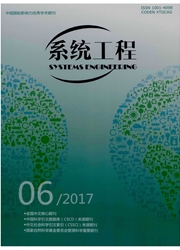

 中文摘要:
中文摘要:
通过对我国上市商业银行的内部运营结构进行分析,将银行的总体经营过程分为资金组织、资金配置和资金获利这三个相互关联的子过程,建立了相应的三阶段加性DEA效率评价模型,并利用该模型研究了2007~2011年我国14家上市商业银行总体及三个运营阶段的技术效率、纯技术效率和规模效率。结果表明,国有商业银行的总技术效率普遍低于股份制商业银行和城市商业银行;14家上市商业银行资金配置阶段的平均效率最高,而资金获利阶段的效率最低,并且该阶段的无效是导致各上市银行整体无效的主要原因。
 英文摘要:
英文摘要:
Through analyzing the internal operating structure of the listed commercial banks, the bank's overall business process is divided into three interrelated sub-processes: the capital organization, capital allocation and capital profit, then establishing the efficiency evaluation model of the three-stage additive DEA, calculating and analyzing the technical efficiency, pure technical efficiency and scale efficiency of the 14 listed commercial banks' in whole and the three operational phases by this model during 2007 to 2011. Results show that the total technical efficiency of the state-owned commercial banks is generally lower than that of the joint-stock commercial banks and the urban commercial banks; the average efficiency of the capital allocation stage of the 14 listed commercial banks is the highest, but the average efficiency of the capital profit is the lowest ; and the inefficiency of the capital profit is the main reason for the whole inefficiency of the listed commercial banks.
 同期刊论文项目
同期刊论文项目
 同项目期刊论文
同项目期刊论文
 Knowledge Complementarity, Knowledge Absorption Effectiveness, and New Product Performance: The Expl
Knowledge Complementarity, Knowledge Absorption Effectiveness, and New Product Performance: The Expl Projective ART with buffers for the high dimensional space clustering and an application to discover
Projective ART with buffers for the high dimensional space clustering and an application to discover The effect of strategic alliance resource accumulation and process characteristics on new product su
The effect of strategic alliance resource accumulation and process characteristics on new product su Learning, Pricing, Timing and Hedging of the Option to Invest for Perpetual Cash Flows with Idiosync
Learning, Pricing, Timing and Hedging of the Option to Invest for Perpetual Cash Flows with Idiosync A New Method for Setting Futures Portfolios’ Maintenance Margins: Evidence from Chinese Commodity Fu
A New Method for Setting Futures Portfolios’ Maintenance Margins: Evidence from Chinese Commodity Fu The expected discounted penalty function for two classes of risk processes perturbed by diffusion wi
The expected discounted penalty function for two classes of risk processes perturbed by diffusion wi Cross-correlations between WTI crude oil market and U.S. stock market: A perspective from econophysi
Cross-correlations between WTI crude oil market and U.S. stock market: A perspective from econophysi Utility-Based Pricing, Timing and Hedging of an American Call Option under an Incomplete Market with
Utility-Based Pricing, Timing and Hedging of an American Call Option under an Incomplete Market with Almost Everywhere Convergence of Riesz Means Related to Schrodinger Operator with Constan Magnetic F
Almost Everywhere Convergence of Riesz Means Related to Schrodinger Operator with Constan Magnetic F Correlation structure and dynamics of international real estate securities markets: A network perspe
Correlation structure and dynamics of international real estate securities markets: A network perspe Optimal Proportional Reinsurance and Investment Problem with Constraints on Risk Control in a Genera
Optimal Proportional Reinsurance and Investment Problem with Constraints on Risk Control in a Genera On the expected discounted penalty function for the classic risk model with potentially delayed clai
On the expected discounted penalty function for the classic risk model with potentially delayed clai 期刊信息
期刊信息
